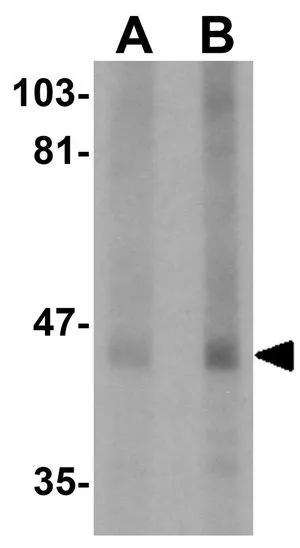
WB analysis of human lung tissue lysate using GTX85240 CKIP1 antibody. Working concentration : (A) 1 and (B) 2 microg/ml
CKIP1 antibody
GTX85240
ApplicationsWestern Blot, ELISA
Product group Antibodies
ReactivityHuman, Mouse, Rat
TargetPLEKHO1
Overview
- SupplierGeneTex
- Product NameCKIP1 antibody
- Delivery Days Customer9
- Application Supplier NoteWB: 1 - 2 microg/mL. *Optimal dilutions/concentrations should be determined by the researcher.Not tested in other applications.
- ApplicationsWestern Blot, ELISA
- CertificationResearch Use Only
- ClonalityPolyclonal
- Concentration1 mg/ml
- ConjugateUnconjugated
- Gene ID51177
- Target namePLEKHO1
- Target descriptionpleckstrin homology domain containing O1
- Target synonymscasein kinase 2-interacting protein 1; C-Jun-binding protein; CK2 interacting protein 1; HQ0024c protein; CK2-interacting protein 1; CKIP1; CKIP-1; JBP; OC120; osteoclast maturation-associated gene 120 protein; PH domain-containing family O member 1; pleckstrin homology domain-containing family O member 1
- HostRabbit
- IsotypeIgG
- Protein IDQ53GL0
- Protein NamePleckstrin homology domain-containing family O member 1
- Scientific DescriptionCKIP1 was identified through a yeast-two hybrid screening as a protein that would interact with only one of the two catalytic subunits of the casein kinase 2 complex. CKIP1 is a pleckstrin homology domain-containing protein localized within the nucleus and at the plasma membrane that interacts with CK2alpha but not CK2alpha, and is thought to play a role in targeting CK2alpha to a particular cellular location. CKIP1 has been implicated in muscle differentiation and the regulation of cell morphology and actin cytoskeleton. CKIP1 can also interact with other proteins such as ATM, an upstream kinase of p53, and recruit the nuclear ATM to the plasma membrane, suggesting CKIP1 may regulate ATM function through re-localizing ATM. CKIP1 can also form a complex with the kinase AKT, leading to a down-regulation of PI3K/AKT signaling and suppression of tumor growth in vivo.
- ReactivityHuman, Mouse, Rat
- Storage Instruction-20°C or -80°C,2°C to 8°C
- UNSPSC12352203
